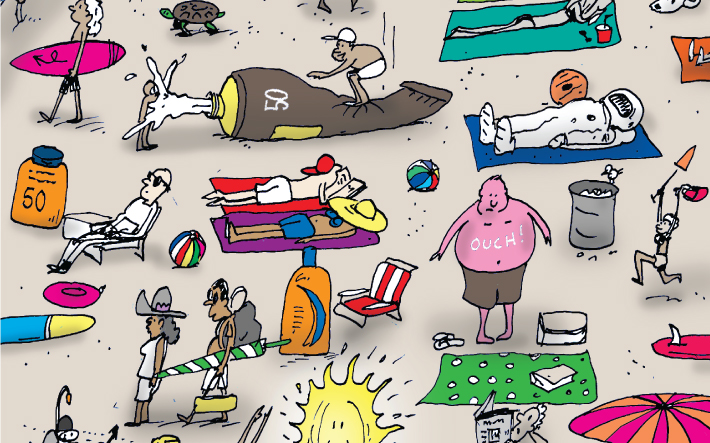Sunscreen has only been around a century but pharmacy shelves are now lined with an assortment of sunscreens with a variety of active ingredients aimed to please everyone from the outdoorsman to the beauty-conscious shopper. The timeline below from the National Library of Medicine tells a brief story of sunscreen.
1798: Robert Willan, the father of modern dermatology, describes a skin condition called eczema solare, or skin sensitivity to light.
1820: English physician Sir Everard Home first proposes that skin pigmentation has protective effects against the sun and that a component of sunlight other than heat affects the skin.
1878: Otto Veiel of Austria describes tannins as a form of sun protection. However, the darkening effect of tannins on the skin prevents them from being commercialized as a sunscreen.
1889: Erik Johan Widmark of Stockholm publishes a landmark study that experimentally proves UV radiation can cause skin erythema and burns.
1891: Dr. Hammer of Stuttgart, Germany, is the first to specifically recommend the use of chemical sunscreens to prevent UV radiation from causing erythema solare of the skin; he uses quinine prepared in an ointment as the first human sunscreen.
1896: Dr. Paul Unna, a German physician, first describes an association between sun exposure and skin cancer: he explains precursor skin cancer changes, such as hyperkeratosis, on sun-exposed skin.
1910: Dr. Unna develops a sunscreen from chestnut extract, sold under the names “Zeozon” and “Ultrazeozon.”
1920s: Coco Chanel popularizes the idea of tanning after photographs of her are taken following a Mediterranean cruise. Her friend, Prince Jean-Louis de Faucigny-Lucigne, says: “I think she may have invented sunbathing.” Tanned skin becomes a sign of a healthy, leisurely, and privileged way of life in Western culture.
 1928: Dr. G. M. Findlay publishes a paper with the first experimental proof of the association between UV radiation and skin cancer in an animal study (mice).
1928: Dr. G. M. Findlay publishes a paper with the first experimental proof of the association between UV radiation and skin cancer in an animal study (mice).
1935: Eugene Schueler, founder of today’s L’Oréal, develops the first tanning oil with UV radiation-filtering properties; the active ingredient is benzyl salicylate.
1938: Swiss chemist Franz Greiter gets sunburned while climbing Mt. Piz Buin — an event that will inspire him to create the first modern sunscreen a decade later.
1942: Stephen Rothman and Jack Rubin first describe para-aminobenzoic acid, active ingredients that will become the most popular in sunscreens in the U.S. for many years.
1942: The Army Air Force approaches the American Medical Association Council of Pharmacy and Chemistry for a “top secret experiment” to study the most effective protective substances to prevent sunburn of men stranded in the desert or on life rafts. They find that dark red veterinary petroleum is waterproof, inexpensive and free of toxicity.
1944: Pharmacist Benjamin Green, who served as an airman during World War II and used red veterinary petroleum, develops a more pleasing, consumer-friendly version of the product by adding cocoa butter and coconut oil, a combination that eventually becomes the Coppertone suntan lotion.
1946: Swiss chemist Franz Greiter develops and commercializes the first modern sunscreen, known as “Gletscher Crème,” or Glacier Cream. He names his brand Piz Buin in honor of the mountain he climbed.
1962: Greiter is credited with inventing the sun protection factor (SPF) rating; the original Gletscher Crème has an SPF rating of 2.
1967: Water-resistant sunscreens are developed.
1978: The U.S. Food and Drug Administration begins to regulate the booming sunscreen market. UV tanning beds also start to appear in the U.S.
1980s: Australia, followed by other countries, accepts the definition of SPF as “the ratio of UV energy needed to produce a minimal erythemal dose on protected to unprotected skin.” SPF becomes the standard in testing sunscreen formulations.
1990s: Most sunscreen products in the market have SPFs ranging from 15 to 30; avobenzone (with octyl triazone added to increase photostability) is the most common ingredient for UVA protection, whereas octyl methoxycinnamate is the most common ingredient for UVB protection.
2007: The International Agency for Research on Cancer publishes a landmark study confirming the association between tanning beds and melanoma.
2008: Marine scientist Roberto Danovaro and colleagues publish the first study describing the potential role of sunscreen ingredients causing coral bleaching in areas with high levels of human recreational use.
2018: Following ecotoxicologist Craig Downs and colleagues’ paper raising concern for potential harm of two sunscreen ingredients — oxybenzone and octinoxate — on coral bleaching and underwater ecosystems, Hawaii becomes the first state to pass a bill banning the sale of sunscreens containing oxybenzone and octinoxate, active ingredients found in most major sunscreen brands.
2019: The FDA‘s Muraili Matta and colleagues’ study in the Journal of the American Medical Association details the application of four commonly available sunscreens on healthy volunteers that resulted in plasma concentrations above the exceeded level established by the FDA for waiving nonclinical toxicology studies for sunscreen. The active ingredients included in the study are avobenzone, oxybenzone, octocrylene, and ecamsule. This study has served as a catapult for the need for further studies to determine the significance of these findings as the chemicals were being absorbed by the body.
Sources: National Library of Medicine, American Academy of Dermatology, American Cancer Society, Cancernet.org, Melanoma Research Foundation
𝗖𝗿𝗲𝗱𝗶𝘁𝘀, 𝗖𝗼𝗽𝘆𝗿𝗶𝗴𝗵𝘁 & 𝗖𝗼𝘂𝗿𝘁𝗲𝘀𝘆: www.mercurynews.com
𝗙𝗼𝗿 𝗮𝗻𝘆 𝗰𝗼𝗺𝗽𝗹𝗮𝗶𝗻𝘁𝘀 𝗿𝗲𝗴𝗮𝗿𝗱𝗶𝗻𝗴 𝗗𝗠𝗖𝗔,
𝗣𝗹𝗲𝗮𝘀𝗲 𝘀𝗲𝗻𝗱 𝘂𝘀 𝗮𝗻 𝗲𝗺𝗮𝗶𝗹 𝗮𝘁 dmca@enspirers.com




